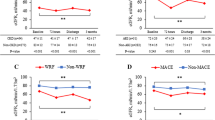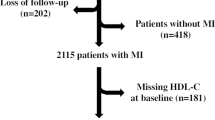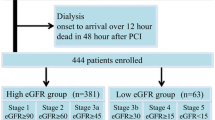Abstract
High low-density lipoprotein-cholesterol to high-density lipoprotein-cholesterol (L/H) ratio is associated with progressions of coronary arteriosclerosis and chronic kidney disease. On the other hand, renal function markedly declined after acute myocardial infarction (AMI). The aims of the present study were (1) to identify what type of patients with AMI would have high L/H ratio at follow-up and (2) to evaluate whether decline in renal function after AMI had accelerated or not in patients with high L/H ratio. The 190 eligible AMI patients who underwent primary percutaneous coronary intervention (PCI) and received atorvastatin (10 mg) were divided into one of two groups according to the L/H ratio at 6-month follow-up: L/H >2 group (n = 81) or L/H ≤2 group (n = 109). The characteristics on admission in the two groups were examined. Furthermore, changes in serum creatinine (sCr) and estimated glomerular filtration rate (eGFR) during 1- and 6-month follow-up were compared between the two groups. L/H >2 group were significantly younger and had greater body mass index (BMI) and worse lipid profile on admission compared with L/H ≤2 group. Percentage increase in sCr and percentage decrease in eGFR during 1-month follow-up in L/H >2 group tended to be greater than in L/H ≤2 group, and those during 6-month follow-up were significantly greater (16.5 ± 2.77 vs. 9.79 ± 2.23 %, p = 0.03 and 11.8 ± 1.93 vs. 2.75 ± 3.85 %, p = 0.04, respectively). In AMI patients undergoing primary PCI, those who were young and had large BMI and poor lipid profile on admission were likely to have a high L/H ratio at follow-up despite statin therapy. In addition, the decline in renal function after AMI had significantly accelerated in patients with high L/H ratio.



Similar content being viewed by others
References
Nicholls SJ, Tuzcu EM, Sipahi I, Grasso AW, Schoenhagen P, Hu T, Wolski K, Crowe T, Desai MY, Hazen SL, Kapadia SR, Nissen SE (2007) Statins, high-density lipoprotein cholesterol, and regression of coronary atherosclerosis. JAMA 297:499–508
Matsumoto I, Miyake Y, Mizukawa M, Takagi Y (2011) Impact of low-density lipoprotein cholesterol/high-density lipoprotein cholesterol ratio on long-term outcome in patients undergoing percutaneous coronary intervention. Circ J 75:905–910
Mulec H, Johnsen SA, Wiklund O, Björck S (1993) Cholesterol: a renal risk factor in diabetic nephropathy? Am J Kidney Dis 22:196–201
Ravid M, Brosh D, Ravid-Safran D, Levy Z, Rachmani R (1998) Main risk factors for nephropathy in type 2 diabetes mellitus are plasma cholesterol levels, mean blood pressure, and hyperglycemia. Arch Intern Med 158:998–1004
Samuelsson O, Mulec H, Knight-Gibson C, Attman PO, Kron B, Larsson R, Weiss L, Wedel H, Alaupovic P (1997) Lipoprotein abnormalities are associated with increased rate of progression of human chronic renal insufficiency. Nephrol Dial Transplant 12:1908–1915
Muntner P, Coresh J, Smith JC, Eckfeldt J, Klag MJ (2005) Plasma lipids and risk of developing renal dysfunction: the atherosclerosis risk in communities study. Kidney Int 58:293–301
Mänttäri M, Tiula E, Alikoski T, Manninen V (1995) Effects of hypertension and dyslipidemia on the decline in renal function. Hypertension 26:670–675
Hillege HL, van Gilst WH, van Veldhuisen DJ, Navis G, Grobbee DE, de Graeff PA, de Zeeuw D (2003) Accelerated decline and prognostic impact of renal function after myocardial infarction and the benefits of ACE inhibition: the CATS randomized trial. Eur Heart J 24(5):412–420
Schwartz GG, Olsson AG, Ezekowitz MD, Ganz P, Oliver MF, Waters D, Zeiher A, Chaitman BR, Leslie S, Stern T, Myocardial Ischemia Reduction with Aggressive Cholesterol Lowering (MIRACL) Study Investigators (2001) Effects of atorvastatin on early recurrent ischemic events in acute coronary syndromes: the MIRACL study: a randomized controlled trial. JAMA 285:1711–1718
Cannon CP, Braunwald E, McCabe CH, Rader DJ, Rouleau JL, Belder R, Joyal SV, Hill KA, Pfeffer MA, Skene AM, Pravastatin or Atorvastatin Evaluation and Infection Therapy-Thrombolysis in Myocardial Infarction 22 Investigators (2004) Intensive versus moderate lipid lowering with statins after acute coronary syndromes. N Engl J Med 350:1495–1504
Kanadaşi M, Çayli M, Demirtaş M, İnal T, Demor M, Koç M, Avkaroğullari M, Dönmez Y, Usal A, Alhan CC, Şan M (2006) The effect of early statin treatment on inflammation and cardiac events in acute coronary syndrome with low-density lipoprotein cholesterol. Heart Vessels 21:291–297
Fonarow GC, Wright RS, Spencer FA, Fredrick PD, Dong W, Every N, French WJ, National Registry of Myocardial Infarction 4 Investigators (2005) Effect of statin use within the first 24 hours of admission for acute myocardial infarction on early morbidity and mortality. Am J Cardiol 96:611–616
Tonelli M, Isles C, Craven T, Tonkin A, Pfeffer MA, Shepherd J, Sacks FM, Furberg C, Cobbe SM, Simes J, West M, Packard C, Curhan GC (2005) Effect of pravastatin on rate of kidney function loss in people with or at risk for coronary disease. Circulation 112:171–178
Matsuo S, Imai E, Horio M, Yasuda Y, Tomita K, Nitta K, Yamagata K, Tomino Y, Yokoyama H, Hishida A, Collaborators developing the Japanese equation for estimated GFR (2009) Revised equations for estimated GFR from serum creatinine in Japan. Am J Kidney Dis 53:982–992
Nakamura H, Mizuno K, MEGA Study Group (2008) Lowered ratio of low-density lipoprotein cholesterol to high-density lipoprotein cholesterol with lipid-lowering therapy associated with reduction of cardiovascular events in primary prevention: MEGA Study post hoc analysis. Circulation 118:S_1174
Ingelsson E, Schaefer EJ, Contois JH, McNamara JR, Sullivan L, Keyes MJ, Pencina MJ, Schoonmaker C, Wilson PW, D’Agostino RB, Vasan RS (2007) Clinical utility of different lipid measures for prediction of coronary heart disease in men and women. JAMA 298(7):776–785
Franssen R, Monajemi H, Stoes ES, Kastelein JJ (2011) Obesity and dyslipidemia. Med Clin N Am 95(5):893–902
Sakamoto T, Kojima S, Ogawa H, Shimomura H, Kimura K, Ogata Y, Sakaino N, Kitagawa A, Multicenter Study for Aggressive Lipid-Lowering Strategy by HMG-CoA Reductase Inhibitors in Patients With Acute Myocardial Infarction Investigators (2006) Effects of early statin treatment on symptomatic heart failure and ischemic events after acute myocardial infarction in Japanese. Am J Cardiol 97:1165–1171
Athyros VG, Papageorgiou AA, Mercouris BR, Athyrou VV, Symeonidis AN, Basayannis EO, Demitriadis DS, Kontopoulos AG (2002) Treatment with atorvastatin to the National Cholesterol Educational Program goal versus ‘usual’ care in secondary coronary heart disease prevention. The GREek Atorvastatin and Coronary-heart-disease Evaluation (GREACE) Study. Curr Med Res Opin 18:220–228
Burne-Taney MJ, Liu M, Ascon D, Molls RR, Racusen L, Rabb H (2006) Transfer of lymphocytes from mice with renal ischemia can induce albuminuria in naïve mice: a possible mechanism linking early injury and progressive renal disease? Am J Physiol Renal Physiol 291:F981–F986
Hörbelt M, Lee SY, Mang HE, Knipe NL, Sado Y, Kribben A, Sutton TA (2007) Acute and chronic microvascular alterations in a mouse model of ischemic acute kidney injury. Am J Physiol Renal Physiol 293:F688–F695
Zager RA, Johnson AC, Becker K (2011) Acute unilateral ischemic injury induces progressive renal inflammation, lipid accumulation, histone modification, and “end-stage” kidney disease. Am J Physiol Renal Physiol 301:F1334–F1345
Amdur RL, Chawla LS, Amodeo S, Kimmel PL, Palant CE (2009) Outcomes following diagnosis of acute renal failure in U.S. veterans: focus on acute tubular necrosis. Kidney Int 76:1089–1097
Wald R, Quinn RR, Luo J, Li P, Scales DC, Mamdani MM, Ray JG, University of Toronto Acute Kidney Injury Research Group (2009) Chronic dialysis and death among survivors of acute kidney injury requiring dialysis. JAMA 302:1179–1185
Lo LJ, Go AS, Chertow GM, McCulloch CE, Fan D, Ordoñez JD, Hsu CY (2009) Dialysis-requiring acute renal failure increases the risk of progressive chronic kidney disease. Kidney Int 76:893–899
Ishani A, Xue JL, Himmelfarb J, Eggers PW, Kimmel PL, Molitoris BA, Collins AJ (2009) Acute kidney injury increases risk of ESRD among elderly. J Am Soc Nephrol 20:223–228
Wi J, Ko YG, Kim JS, Kim BK, Choi D, Ha JW, Hong MK, Jang Y (2011) Impact of contrast-induced acute kidney injury with transient or persistent renal dysfunction on long-term outcomes of patients with acute myocardial infarction undergoing percutaneous coronary intervention. Heart 97:1753–1757
Athyros VG, Kakafika AI, Papageorgiou AA, Pagourelias ED, Savvatianos SD, Elisaf M, Karagiannis A, Tziomalos K, Mikhailidis DP (2007) Statin-induced increase in HDL-C and renal function in coronary heart disease patients. Open Cardiovasc Med J 1:8–14
Fielding CJ, Fielding PE (1995) Molecular physiology of reverse cholesterol transport. J Lipid Res 36:211–228
Robbesyn F, Augé N, Vindis C, Cantero AV, Barbaras R, Negre-Salvayre A, Salvayre R (2005) High-density lipoproteins prevent the oxidized low-density lipoprotein-induced epidermal [corrected] growth factor receptor activation and subsequent matrix metalloproteinase-2 upregulation. Arterioscler Thromb Vasc Biol 25:1206–1212
Moorhead JF, Chan MK, El-Nahas M, Varghese Z (1982) Lipid nephrotoxicity in chronic progressive glomerular and tubulo-interstitial disease. Lancet 2:1309–1311
Abrass CK (2004) Cellular lipid metabolism and the role of lipids in progressive renal disease. Am J Nephrol 24:46–53
Patel PJ, Khera AV, Jafri K, Wilensky RL, Rader DJ (2011) The anti-oxidative capacity of high-density lipoprotein is reduced in acute coronary syndrome but not in stable coronary artery disease. J Am Coll Cardiol 58:2068–2075
Lee TM, Lin MS, Tsai CH, Chang NC (2005) Add-on and withdrawal effect of pravastatin on proteinuria in hypertensive patients treated with AT receptor blockers. Kidney Int 68:779–787
Buemi M, Allegra A, Corica F, Aloisi C, Giacobbe M, Pettinato G, Corsonello A, Senatore M, Frisina N (2000) Effect of fluvastatin on proteinuria in patients with immunoglobulin A nephropathy. Clin Pharmacol Ther 67:427–431
Zhou Q, Liao JK (2010) Pleiotropic effects of statins: basic research and clinical perspectives. Circ J 74:818–826
Skogastierna C, Luksha L, Kublickiene K, Eliasson E, Rane A, Ekström L (2011) Beneficial vasoactive endothelial effects of fluvastatin: focus on prostacyclin and nitric oxide. Heart Vessels 26:628–636
Lunder M, Ziberna L, Janić M, Jerin A, Skitek M, Sabovič M, Drevenšek G (2012) Low-dose atorvastatin, losartan, and particularly their combination, provide cardiovascular protection in isolated rat heart and aorta. Heart Vessels. doi:10.1007/s00380-012-0259-0
Amann K, Benz K (2011) Statins: beyond lipids in CKD. Nephrol Dial Transplant 26:407–410
Fried LF (2008) Effects of HMG-CoA reductase inhibitors (statins) on progression of kidney disease. Kidney Int 74:571–576
D’Amico G (2006) Statins and renal disease: from primary prevention to renal replacement therapy. J Am Soc Nephrol 17:S148–S152
Conflict of interest
All authors have no financial conflicts of interest to disclose.
Author information
Authors and Affiliations
Corresponding author
Rights and permissions
About this article
Cite this article
Okumura, S., Sakakibara, M., Hayashida, R. et al. Accelerated decline in renal function after acute myocardial infarction in patients with high low-density lipoprotein-cholesterol to high-density lipoprotein-cholesterol ratio. Heart Vessels 29, 7–14 (2014). https://doi.org/10.1007/s00380-012-0321-y
Received:
Accepted:
Published:
Issue Date:
DOI: https://doi.org/10.1007/s00380-012-0321-y




